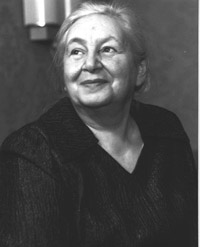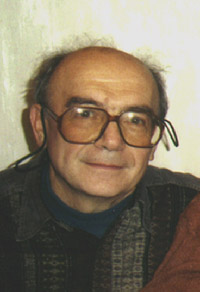|
|
|
V.I.Veksler |
PNLAB history
PNLAB founder was Vladimir I. Veksler (4 march 1907, Zhitomir, Volyn region -
22 September 1966, Moscow). In 1944 he discovered the autophasing principle which
permitted to develop a new type of particle accelerators called synchrotrons
(the name was suggested by McMillan).
|
|
|
V.I.Veksler |
First in the Soviet Union (third in the world) electron synchrotron S-3 (upper energy 30 MeV) which became a base for future PNLAB has been put into operation in 1947 by V.I.Veksler team in Lebedev Physical Institute (FIAN). INR RAS veteran B.S.Ratner was a member of this team. Shortly after the team was reorganized to Etalon Laboratory of FIAN.
In the end of 1948 - beginning of 1949 a first physical investigation was performed at the synchrotron S-3: a study of the bremsstrahlung shape from the synchrotron target. Around this time L.E.Lazareva joined Etalon lab. She came from I.M.Frank laboratory where she had been working in the field of nuclear fission.
In 1949 second electron synchrotron S-25 (upper energy 250 MeV) was put into operation in Etalon lab. A building for this syhchrotron has been constructed in the uptown of Moscow. This was "Pitomnik", now a residence of INR RAS. S-3 accelerator was also transferred to the "Pitomnik" together with L.E.Lazareva sector which has been investigating photonuclear reactions. In 1960 this sector was reorganized to Photonuclear reactions laboratory headed by L.E.Lazareva.
In fact the staff as well as the field of interests of PNLAB have been established already by 1955. From the very beginning the leader of this laboratory became Lyubov E. Lazareva who stayed in this position for over 35 years . When Institute for Nuclear Research was organized in 1970, the PNLAB became one of 3 main divisions included in the new Institute.
 |
|
L.E.Lazareva |
Main topical direction of PNLAB activity has been a study of electromagnetic interactions, mainly in the energy region of the then recently discovered collective nuclear state - giant dipole resonance. In the investigation of photonuclear reactions experimental data analysis becomes most unambiguous since electromagnetic interactions are well studied theoretically while relative weakness of this interaction permits to use the well developed perturbation theory. Furthermore, the electromagnetic interaction excites collective nuclear states most efficiently. At the start of PNLAB activity data on giant resonance cross sections were very scarce and an interest to this work in the world was very high. Correspondingly high was a competition between teams from different labs and countries.
In the initial period a scientific work at S-3 and S-25 accelerators had been carried out by several research groups headed by L.E.Lazareva: photofission group (N.I.Nikitina, N.Kulikova, V.G.Nedorezov), group of the pair magnetic spectrometer (F.A.Nikolaev, B.S.Dolbilkin, V.I.Korin) which had been investigating total photoabsorption cross sections of light and medium nuclei, group of the total absorption (G.V.Solodukhov, G.M.Gurevich) performing similar measurements for heavy nuclei with the use of the scintillation total absorption spectrometer, direct photoeffect group (B.S.Ratner, R.M.Osokina) investigating ( ,p) reactions and later the doorway state decay, and inelastic photon scattering group (O.V.Bogdankevich, F.A.Nikolaev, B.S.Dolbilkin).
A lot of attention has been paid to the development of the experimental technique. L.E.Lazareva suggested an attenuation method which was found to be very effective to obtain data on total photoabsorption cross sections in one experiment using a bremsstrahlung beam (with fixed upper energy). In 1960-1970 measurements of the total photoabsorption cross sections for a number of light and medium nuclei from Be to Pb had been fulfilled in PNLAB. Some of the results became classical, for example the fine structure observed in the phoroabsorption cross section for oxygen. In the following years total cross section measurements had been made for a large number of heavy nuclei, including fissionable.
Later, after putting into operation of the high current electron linac LUE-100 an inelastic electron scattering (B.S.Dolbilkin, R.L.Kondratiev, V.P.Lisin), has been investigated as well as reactions leading to a formation of spontaneously fissioning isomers and a fotofission of very heavy nuclei (V.G.Nedorezov). Gamma beam monochromatization using positron annihilation in flight has been realized (V.Obozny, L.Z.Dzhilavyan). Photoproton and photoneutron spectrometers, precision electron magnetic spectrometer have been developed.
In 1986 the head of PNLAB became Rudolf A. Eramzhyan . He has made a lot for further development of the lab. The theory group was organized. New directions of investigations were initiated, such as a study of spin depending phenomena in experiments with oriented nuclei (G.M.Gurevich).
 |
|
R.A.Eramzhyan |
PNLAB has a reputation of one of the leading world centers in the study of the electromagnetic interactions. Many of its results became classical and have a large citation index. PNLAB always contributed to a development of the photonuclear reaction studies in other cities. E.g., with the help of L.E.Lazareva photonuclear centers were organized in Saratov and Uzhgorod. Collaboration programs with KIPT (Kharkov), Budker Institute (Novosibirsk), JINR (Dubna) have been developed. For many years PNLAB continuously participated in various international projects including CERN (project PC-203), Saclay etc. Regularly, International Seminars on Electromagnetic Interactions of Nuclei at Low and Medium Energies have been organized by PNLAB in Moscow. X Seminar was in 2003, XI Seminar will be in 2006.
PNLAB staff consists now of 42 persons, including 20 research associates, between them 11 Candidates of Science and 2 Doctors of Science. Laboratory head is Vladimir G. Nedorezov. Apart from the above mentioned facilities PNLAB has 9 MeV high current electron linac which is used for medical equipment sterilization. A construction of continuous beam race-track microtron (170 MeV) is in progress. Unique facility NORD-2 intended for low-temperature spin orientation of atomic nuclei has been designed and constructed in PNLAB. Experimental and theoretical investigations in the field of electromagnetic interactions and neighboring topics of nuclear physics are carried out.
PNLAB is widely represented in leading Russian and international collaborations in the field of electromagnetic interactions. At the electron storage ring "Sibir-2" in Kurchatov Institute a facility for photonuclear reaction studies at medium energies is being constructed. PNLAB takes part in photofission experiments at Jlab. In Mainz at MAMI-B accelerator people from PNLAB are investigating a Compton scattering at nucleons, total photoabsorption cross sections and partial reactions in the baryon resonance region, spin structure of nucleons, perform an experimental test of the GDH sum rule. At the ESRF electron storage ring (GRAAL project at Grenoble) investigations of heavy meson photoproduction and Compton effect at polarized tagged photons are in progress. PNLAB participates in the international DELTA-SIGMA collaboration studying spin depending effects in NN scattering at JINR (Dubna).
A pioneer world level work was the direct measurement of
the total photoabsorption cross section for a number of light nuclei using
the attenuation method suggested in PNLAB. A fine structure of the giant
dipole resonance was first observed. Total photoabsorption cross sections of
heavy nuclei (up to 94Pu) were first measured by the attenuation method
confirming its universality.
First in the world (in collaboration with Budker Institute,
Novosibirsk) photonuclear studies has been performed using backscattered
Compton photon beam. In these experiments a deviation from the universal
energy dependence in total photoabsorption cross sections of actinide nuclei
was first found.
First in the world the study of a relation between the alpha decay angular anisotropy and nuclear deformation / nuclear structure for strongly deformed heavy transuranium isotopes (Am, Es, Fm) has been performed using the method of low temperature (below 0.1 K) nuclear spin orientation technique.
First in the world a multi-turn injection system for a ring accelerator had been realised using coupled betatron oscillations and a magnet-current channel to increase the electron beam intensity.